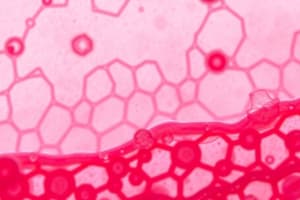Podcast
Questions and Answers
Which type of tissue is primarily responsible for absorption and secretion in the digestive tract?
Which type of tissue is primarily responsible for absorption and secretion in the digestive tract?
- Stratified squamous epithelium
- Simple columnar epithelium (correct)
- Pseudostratified columnar epithelium
- Simple cuboidal epithelium
What is the main characteristic of simple squamous epithelium?
What is the main characteristic of simple squamous epithelium?
- Facilitates rapid diffusion and filtration (correct)
- Forms protective layers on body surfaces
- Supports and binds other tissues
- Produces a lubricating mucus
Which epithelium type is highly modified to accommodate stretching in the urinary bladder?
Which epithelium type is highly modified to accommodate stretching in the urinary bladder?
- Stratified squamous epithelium
- Pseudostratified ciliated columnar epithelium
- Transitional epithelium (correct)
- Simple cuboidal epithelium
Which of the following best describes stratified squamous epithelium?
Which of the following best describes stratified squamous epithelium?
Which type of epithelium contains goblet cells that produce mucus?
Which type of epithelium contains goblet cells that produce mucus?
What is the primary function of loose connective tissue?
What is the primary function of loose connective tissue?
Where are stratified cuboidal and stratified columnar epithelium primarily found?
Where are stratified cuboidal and stratified columnar epithelium primarily found?
What distinguishes pseudostratified columnar epithelium from other types of epithelial tissues?
What distinguishes pseudostratified columnar epithelium from other types of epithelial tissues?
What is the primary component of the extracellular matrix in dense regular connective tissue?
What is the primary component of the extracellular matrix in dense regular connective tissue?
Which type of connective tissue contains the greatest number of adipocytes?
Which type of connective tissue contains the greatest number of adipocytes?
What allows elastic connective tissue to regain its original size and shape after being stretched?
What allows elastic connective tissue to regain its original size and shape after being stretched?
What is the main characteristic of hyaline cartilage?
What is the main characteristic of hyaline cartilage?
Which type of connective tissue is described as having collagen fibers arranged irregularly?
Which type of connective tissue is described as having collagen fibers arranged irregularly?
What distinguishes fibrocartilage from other types of cartilage?
What distinguishes fibrocartilage from other types of cartilage?
Which feature is true for all types of connective tissue mentioned?
Which feature is true for all types of connective tissue mentioned?
Which structure within cartilage is occupied by chondrocytes?
Which structure within cartilage is occupied by chondrocytes?
Flashcards are hidden until you start studying
Study Notes
Body Tissues Overview
- Composed of similar cells grouped together based on structure and function.
- Four primary tissue types: Epithelial, Connective, Muscular, and Nervous.
Epithelial Tissue
- Functions include absorption, secretion, and filtration; serves as a selective barrier.
- Usually thin and primarily designed for roles other than protection.
Simple Epithelia Types
-
Simple Squamous Epithelium
- Facilitates rapid diffusion; found in alveoli of lungs and capillary walls.
- Forms serous membranes lining the ventral body cavity.
-
Simple Cuboidal Epithelium
- Commonly located in glands, ducts, kidney tubules, and ovaries.
-
Simple Columnar Epithelium
- Contains goblet cells producing mucus; lines the digestive tract (stomach to anus).
- Exists in two forms: nonciliated and ciliated.
-
Pseudostratified Columnar Epithelium
- Primarily involved in absorption and secretion; often ciliated.
Stratified Epithelia Types
-
Stratified Squamous Epithelium
- Provides protection; characterized by squamous cells at the surface and cuboidal or columnar cells near the basement membrane.
- Located in esophagus, mouth, vagina, and outer skin.
-
Stratified Cuboidal and Columnar Epithelium
- Rare tissues found predominantly in large gland ducts.
-
Transitional Epithelium
- Modified stratified squamous tissue; lines organs like the urinary bladder.
- Cells can change shape to accommodate stretching.
Connective Tissue Overview
- Composed of different cell types with varying degrees of extracellular matrix.
Types of Connective Tissue
-
Loose Connective Tissue
- Extracellular fibers are loosely arranged, including collagen, elastic, and reticular fibers.
- Contains fibroblasts and adipocytes, allowing diffusion of interstitial fluids.
-
Dense Connective Tissue
- Packed fibers with minimal ground substance; two main forms:
- Dense Regular Connective Tissue
- Features parallel collagen fibers; also referred to as white fibrous tissue.
- Dense Irregular Connective Tissue
- Collagen fibers are arranged irregularly; lacks significant ground substance.
- Dense Regular Connective Tissue
- Packed fibers with minimal ground substance; two main forms:
-
Elastic Connective Tissue
- Rich in elastic fibers; allows tissue to stretch and return to original shape.
Specialized Connective Tissue
-
Cartilage
- Extracellular matrix contains collagen and elastic fibers within a gelatinous ground substance.
- Chondroblasts secrete fibers and ground substance; become chondrocytes in lacunae.
-
Types of Cartilage
- Hyaline Cartilage
- Most abundant type; characterized by fine collagen fibers.
- Elastic Cartilage
- Similar to hyaline but contains more elastic fibers, allowing flexibility.
- Fibrocartilage
- Contains thick collagen fibers providing tensile strength; fewer lacunae and chondrocytes.
- Hyaline Cartilage
-
Bone
- Characterized by a layered structure (lamellae); incorporates collagen fibers, ground substance, and inorganic materials.
Studying That Suits You
Use AI to generate personalized quizzes and flashcards to suit your learning preferences.




